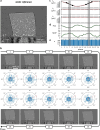Optimising 4D imaging of fast-oscillating structures using X-ray microtomography with retrospective gating
- PMID: 39227377
- PMCID: PMC11372196
- DOI: 10.1038/s41598-024-68684-1
Optimising 4D imaging of fast-oscillating structures using X-ray microtomography with retrospective gating
Abstract
Imaging the internal architecture of fast-vibrating structures at micrometer scale and kilohertz frequencies poses great challenges for numerous applications, including the study of biological oscillators, mechanical testing of materials, and process engineering. Over the past decade, X-ray microtomography with retrospective gating has shown very promising advances in meeting these challenges. However, breakthroughs are still expected in acquisition and reconstruction procedures to keep improving the spatiotemporal resolution, and study the mechanics of fast-vibrating multiscale structures. Thereby, this works aims to improve this imaging technique by minimising streaking and motion blur artefacts through the optimisation of experimental parameters. For that purpose, we have coupled a numerical approach relying on tomography simulation with vibrating particles with known and ideal 3D geometry (micro-spheres or fibres) with experimental campaigns. These were carried out on soft composites, imaged in synchrotron X-ray beamlines while oscillating up to 400 Hz, thanks to a custom-developed vibromechanical device. This approach yields homogeneous angular sampling of projections and gives reliable predictions of image quality degradation due to motion blur. By overcoming several technical and scientific barriers limiting the feasibility and reproducibility of such investigations, we provide guidelines to enhance gated-CT 4D imaging for the analysis of heterogeneous, high-frequency oscillating materials.
Keywords: Fast-oscillating multiscale structures; Motion blur limitation; Retrospective gating; Synchrotron X-ray microtomography; Tomographic simulation; Vibration testing.
© 2024. The Author(s).
Conflict of interest statement
The authors declare no competing interests.
Figures









Similar articles
-
4D micro-CT using fast prospective gating.Phys Med Biol. 2012 Jan 7;57(1):257-71. doi: 10.1088/0031-9155/57/1/257. Phys Med Biol. 2012. PMID: 22156062 Free PMC article.
-
Advances in 4D medical imaging and 4D radiation therapy.Technol Cancer Res Treat. 2008 Feb;7(1):67-81. doi: 10.1177/153303460800700109. Technol Cancer Res Treat. 2008. PMID: 18198927 Review.
-
Low-dose 4D cardiac imaging in small animals using dual source micro-CT.Phys Med Biol. 2018 Jan 9;63(2):025009. doi: 10.1088/1361-6560/aa9b45. Phys Med Biol. 2018. PMID: 29148430 Free PMC article.
-
Geometric validation of self-gating k-space-sorted 4D-MRI vs 4D-CT using a respiratory motion phantom.Med Phys. 2015 Oct;42(10):5787-97. doi: 10.1118/1.4929552. Med Phys. 2015. PMID: 26429253 Free PMC article.
-
A review of techniques for visualising soft tissue microstructure deformation and quantifying strain Ex Vivo.J Microsc. 2018 Dec;272(3):165-179. doi: 10.1111/jmi.12701. Epub 2018 Apr 14. J Microsc. 2018. PMID: 29655273 Review.
References
-
- Maiditsch, I. P., Ladich, F., Heß, M., Schlepütz, C. M. & Schulz-Mirbach, T. Revealing sound-induced motion patterns in fish hearing structures in 4D: A standing wave tube-like setup designed for high-resolution time-resolved tomography. J. Exp. Biol.225, jeb243614. 10.1242/jeb.243614 (2022). 10.1242/jeb.243614 - DOI - PMC - PubMed
LinkOut - more resources
Full Text Sources
Miscellaneous

